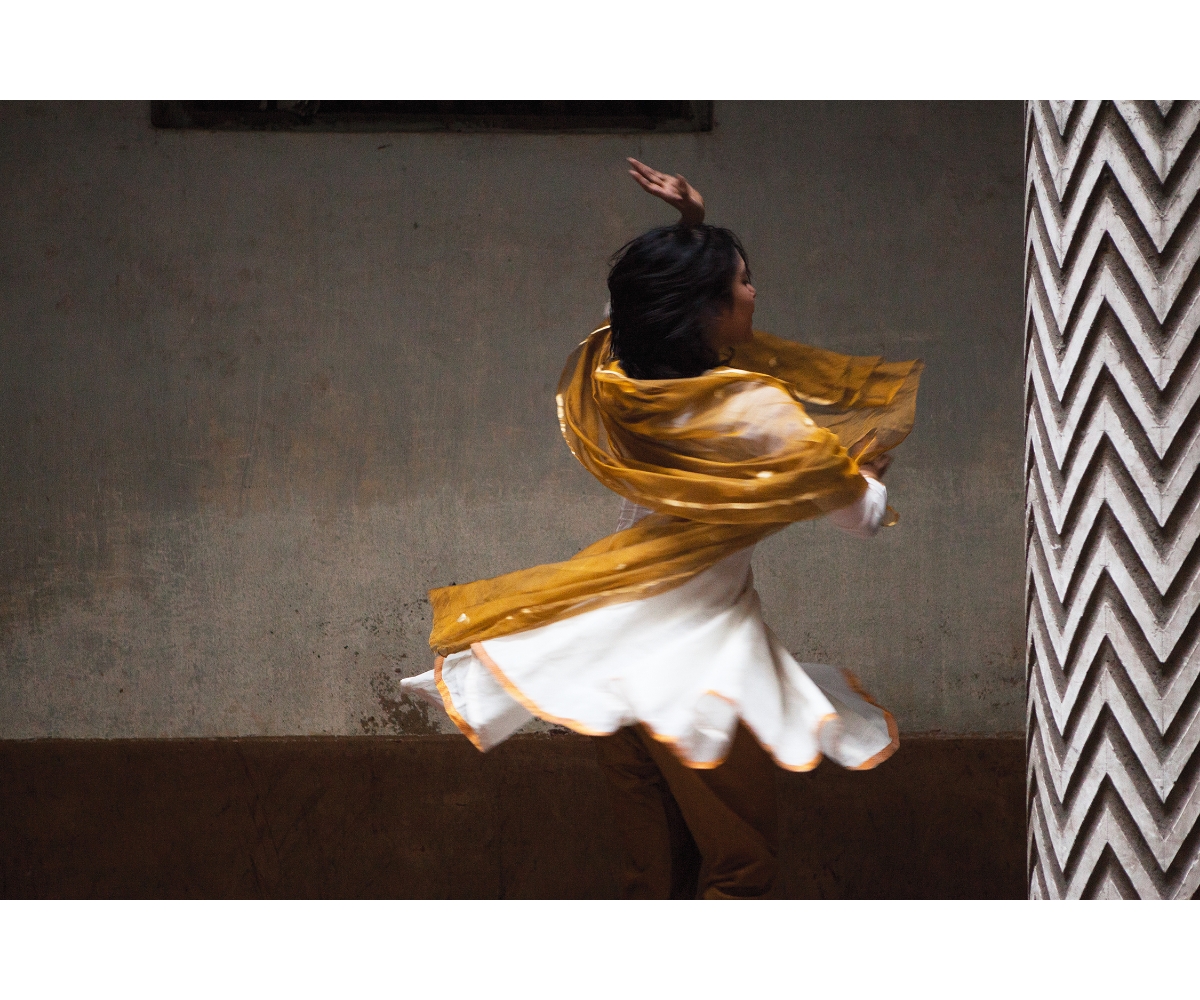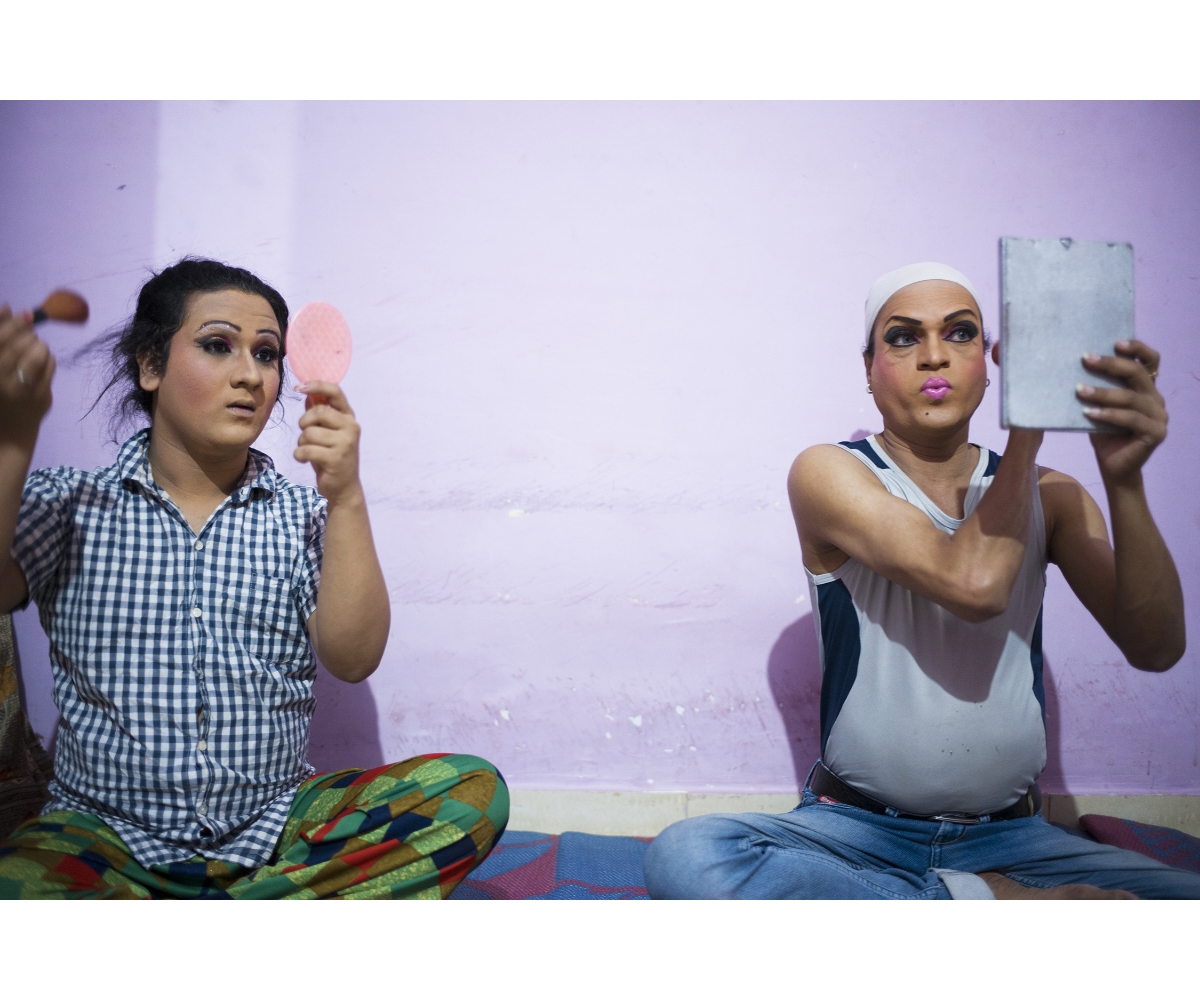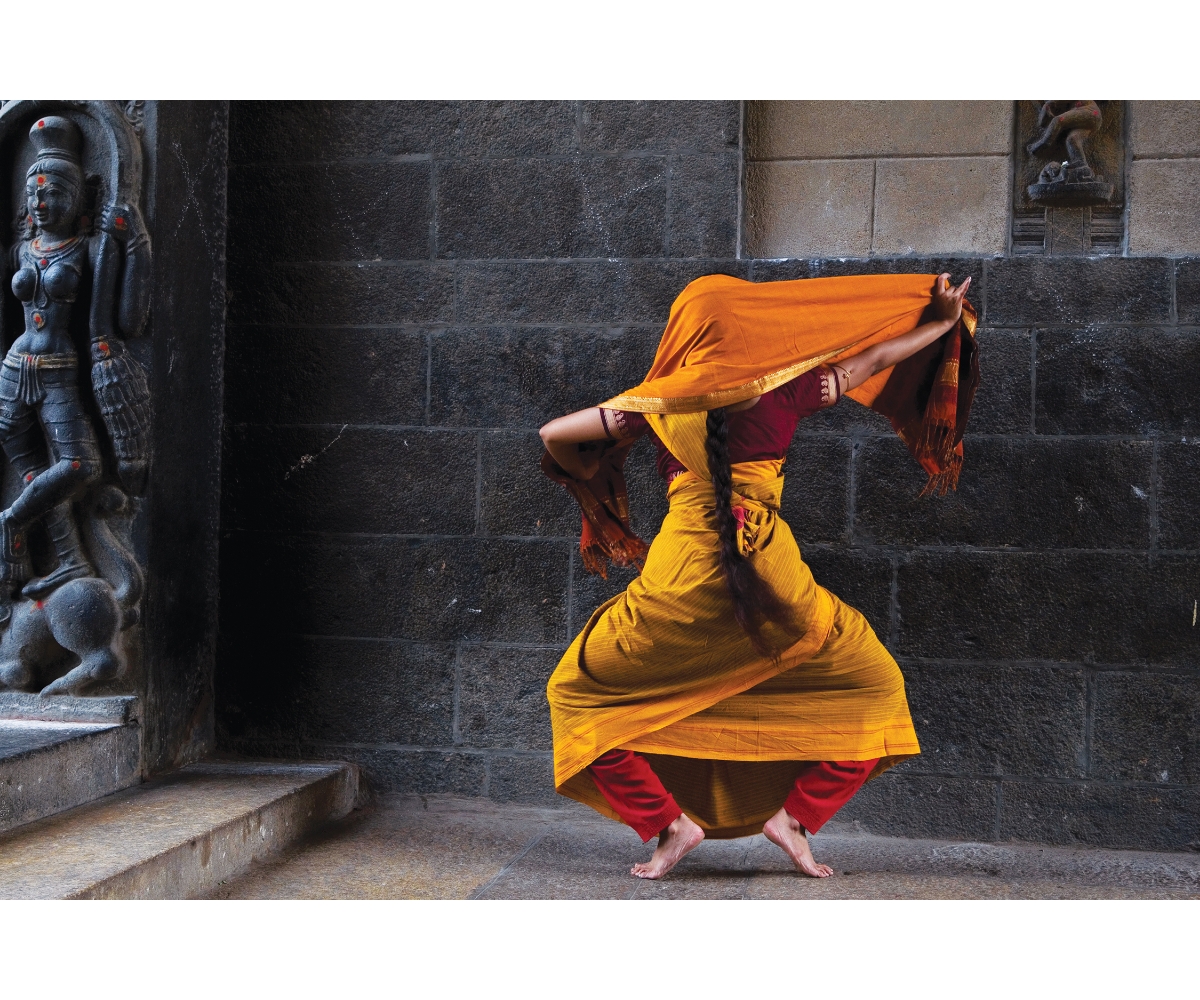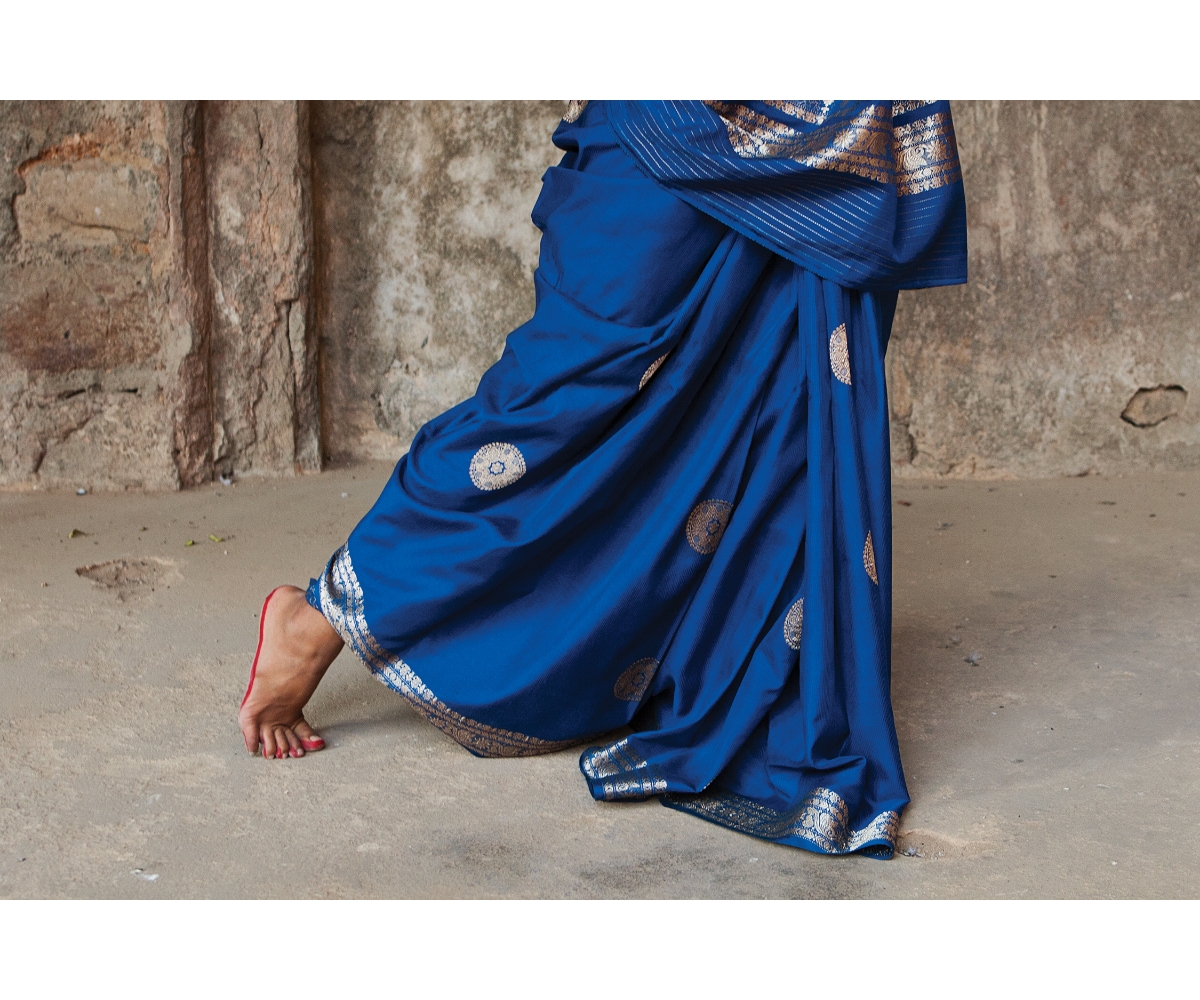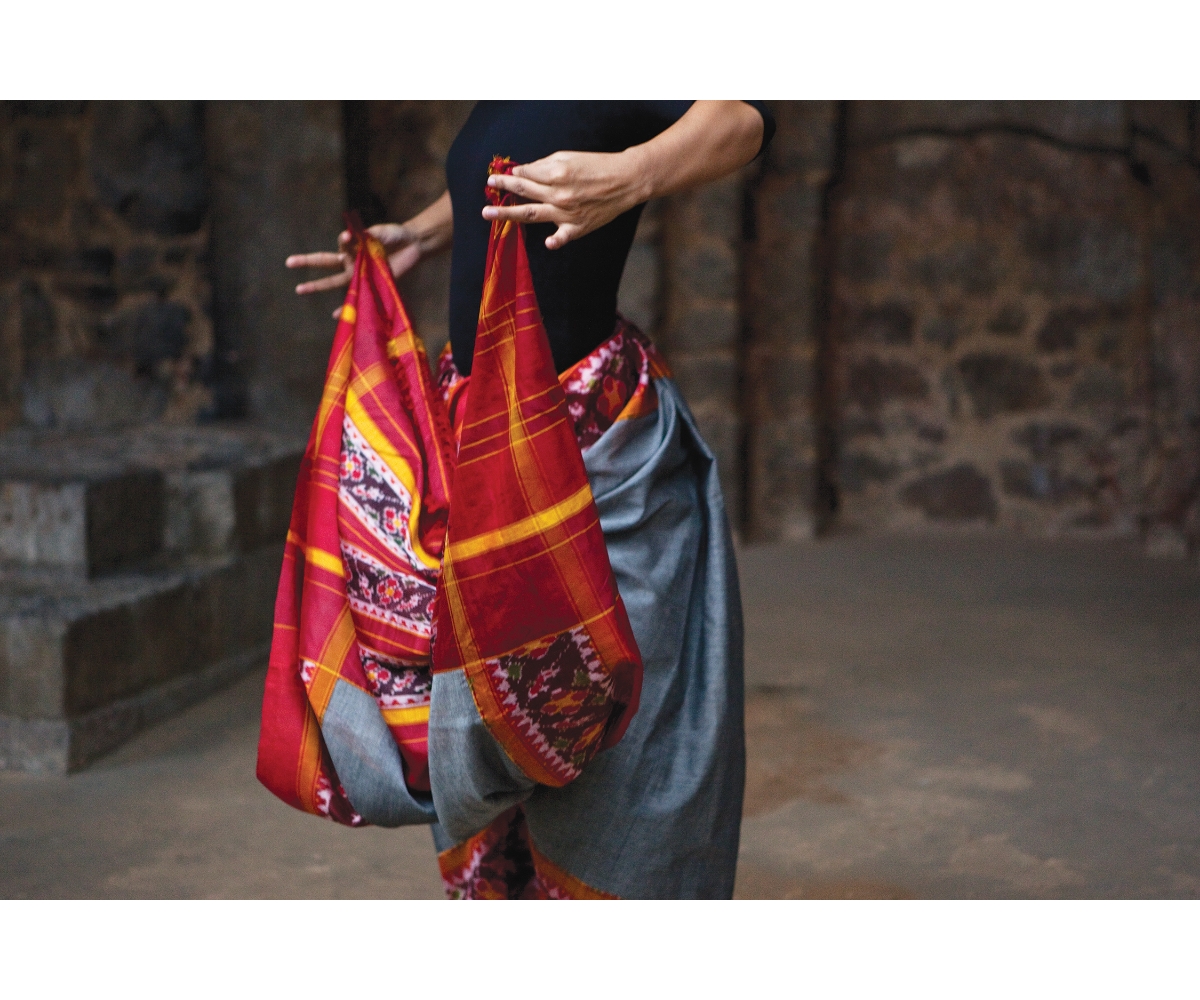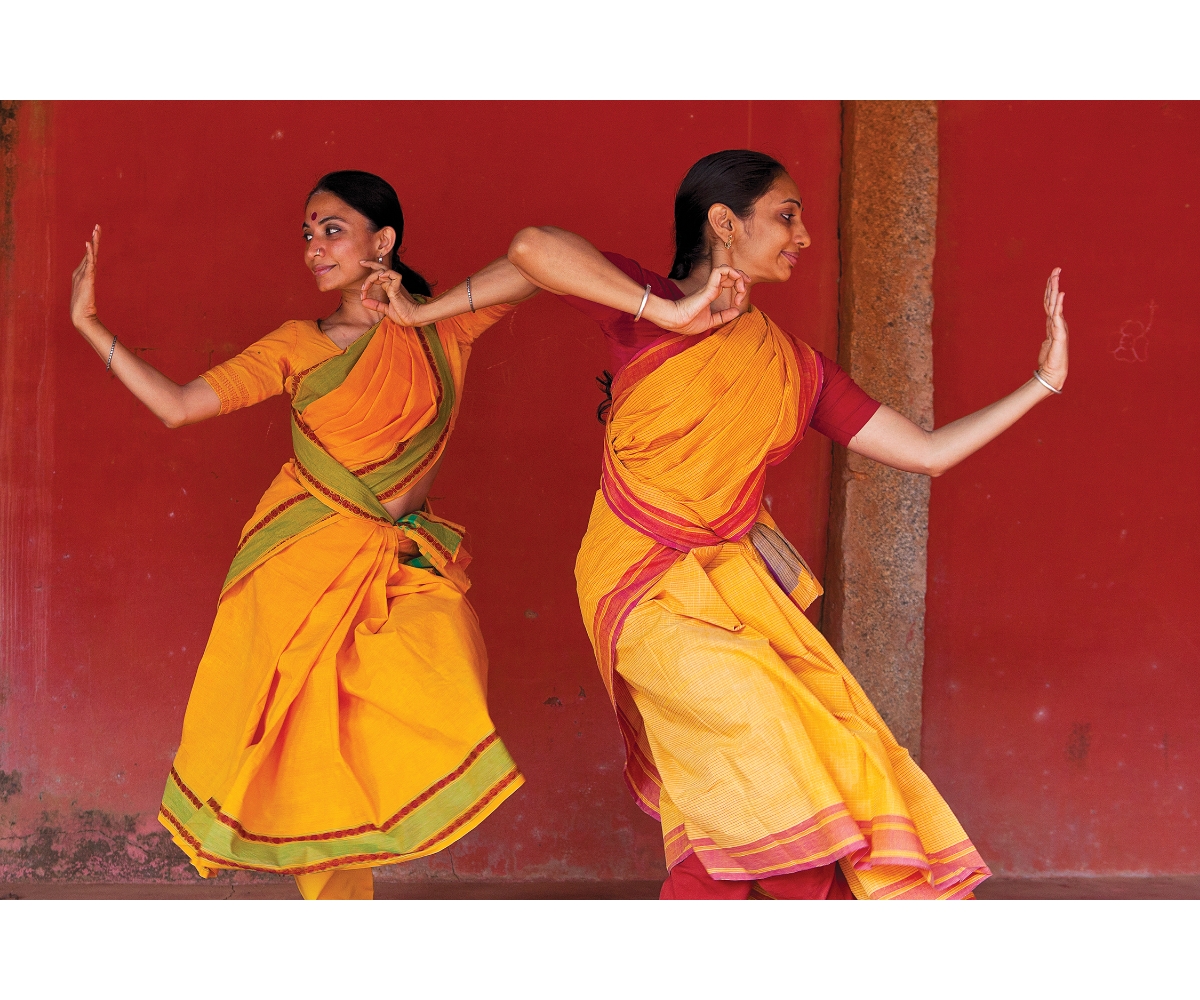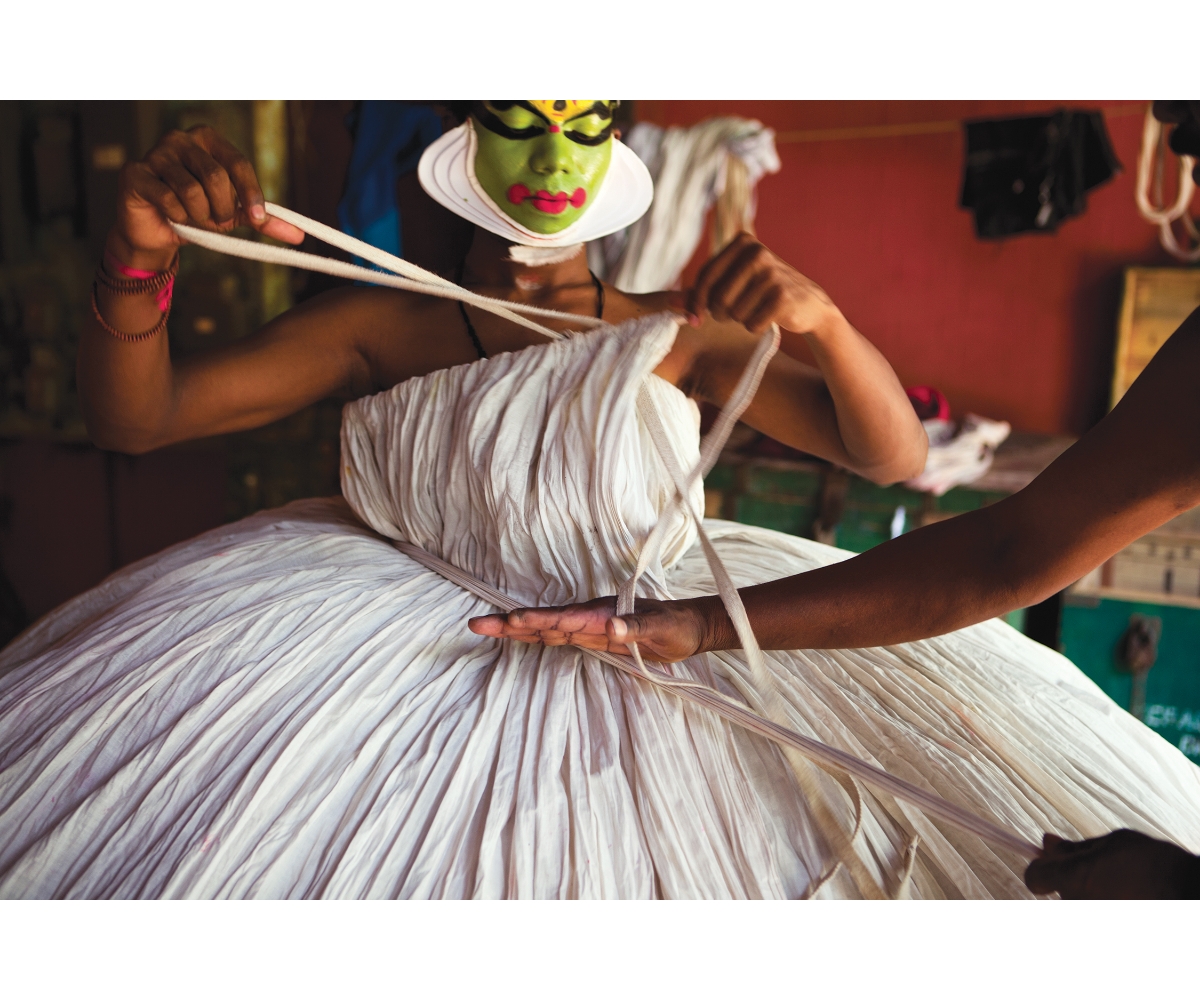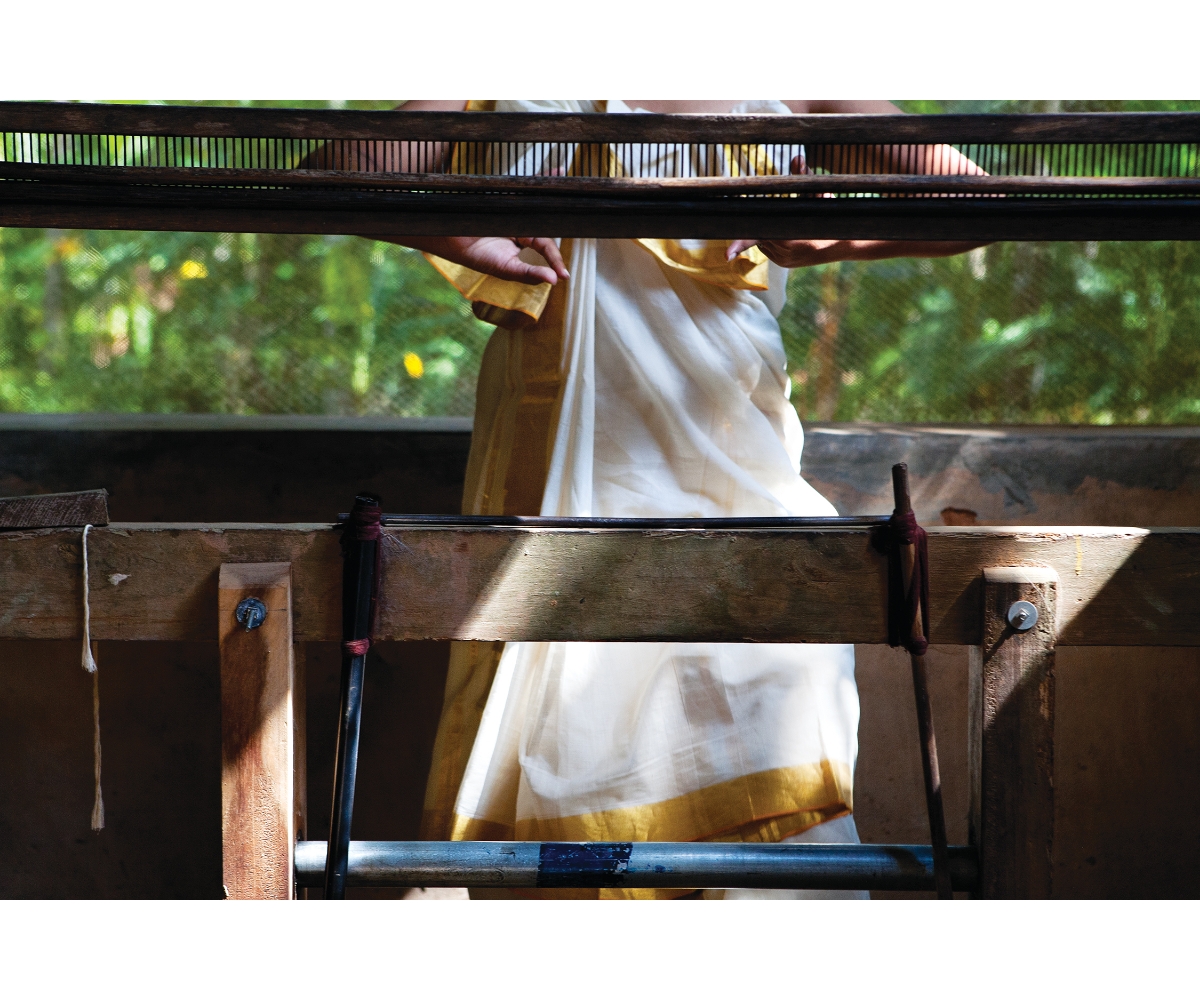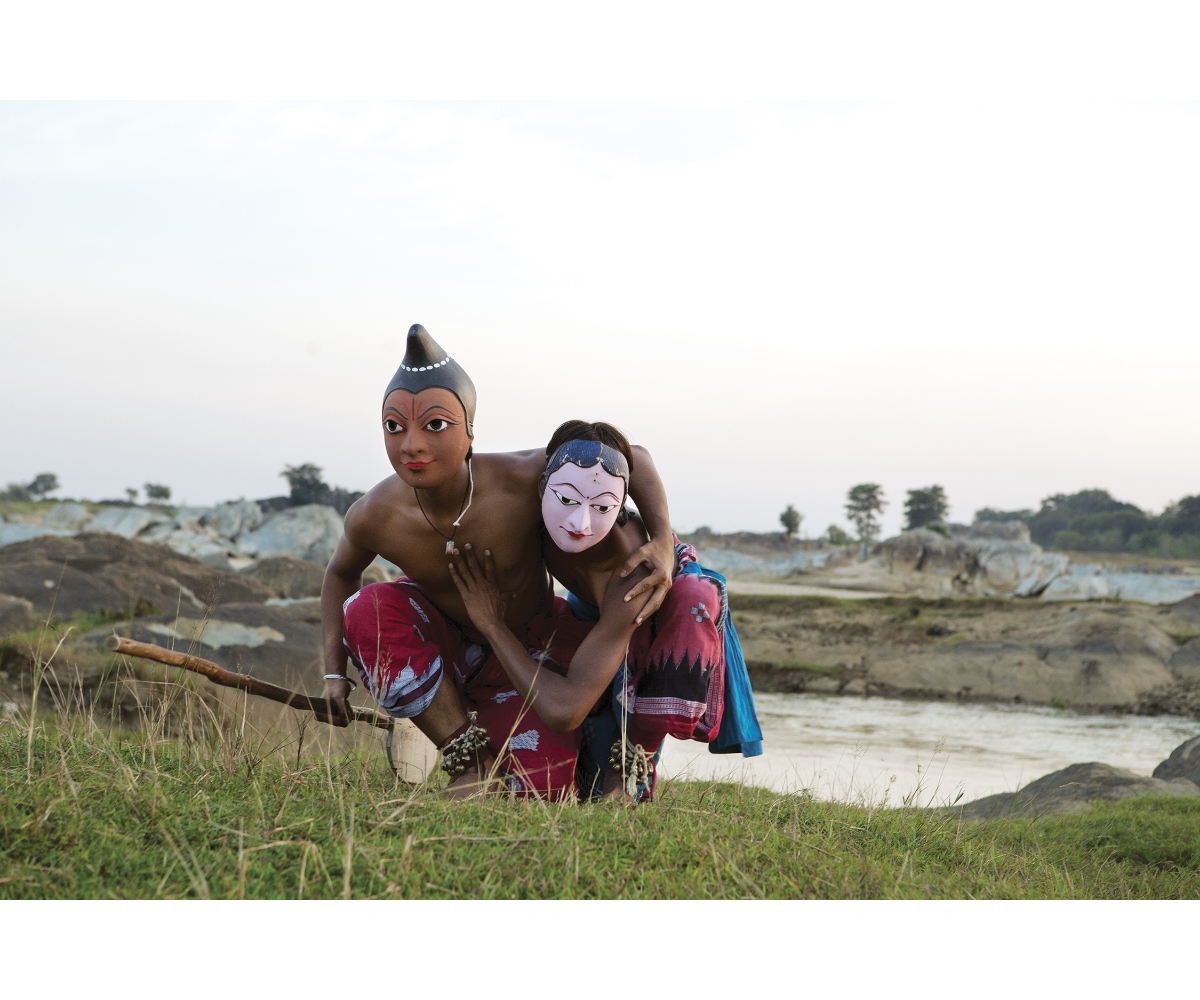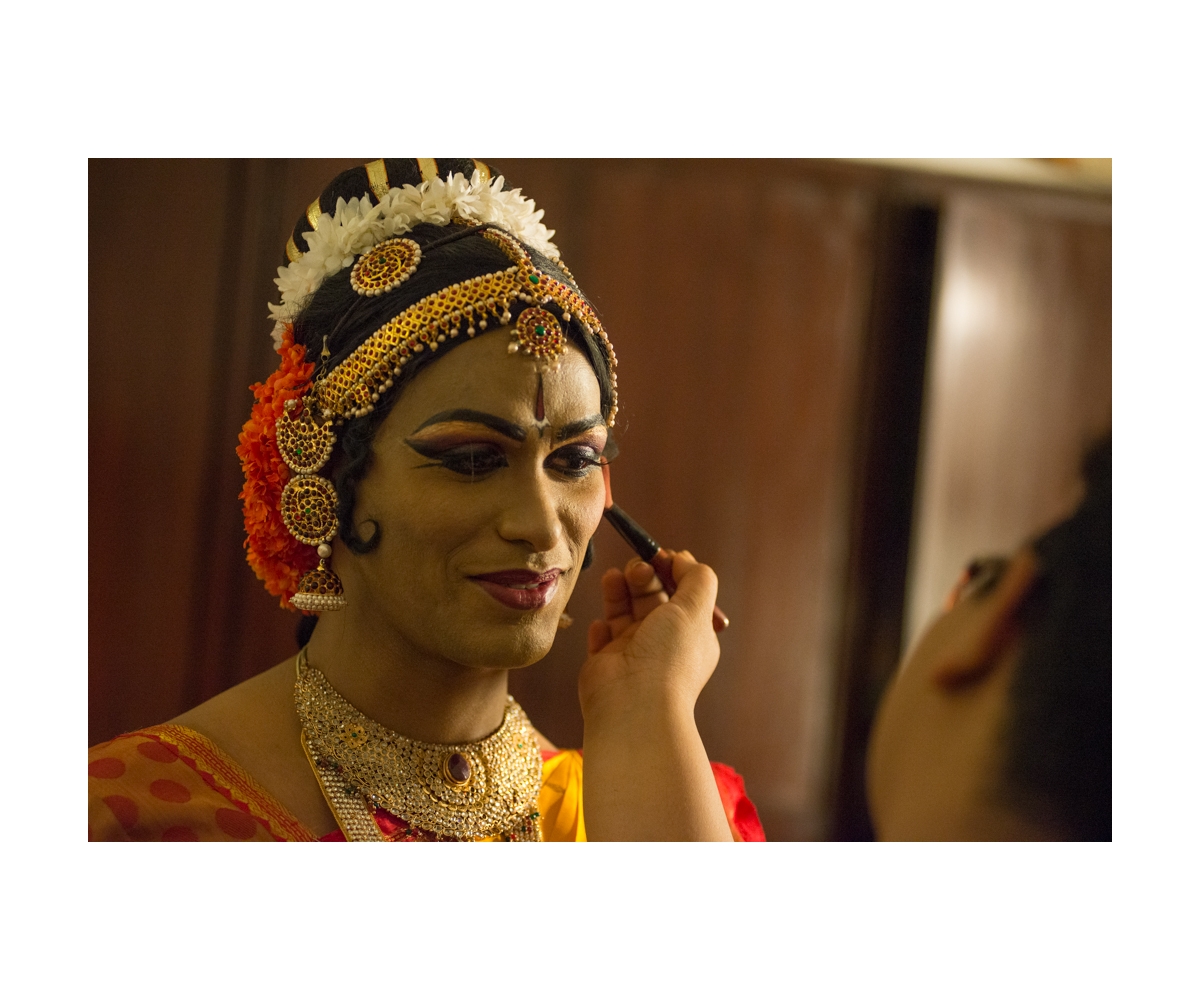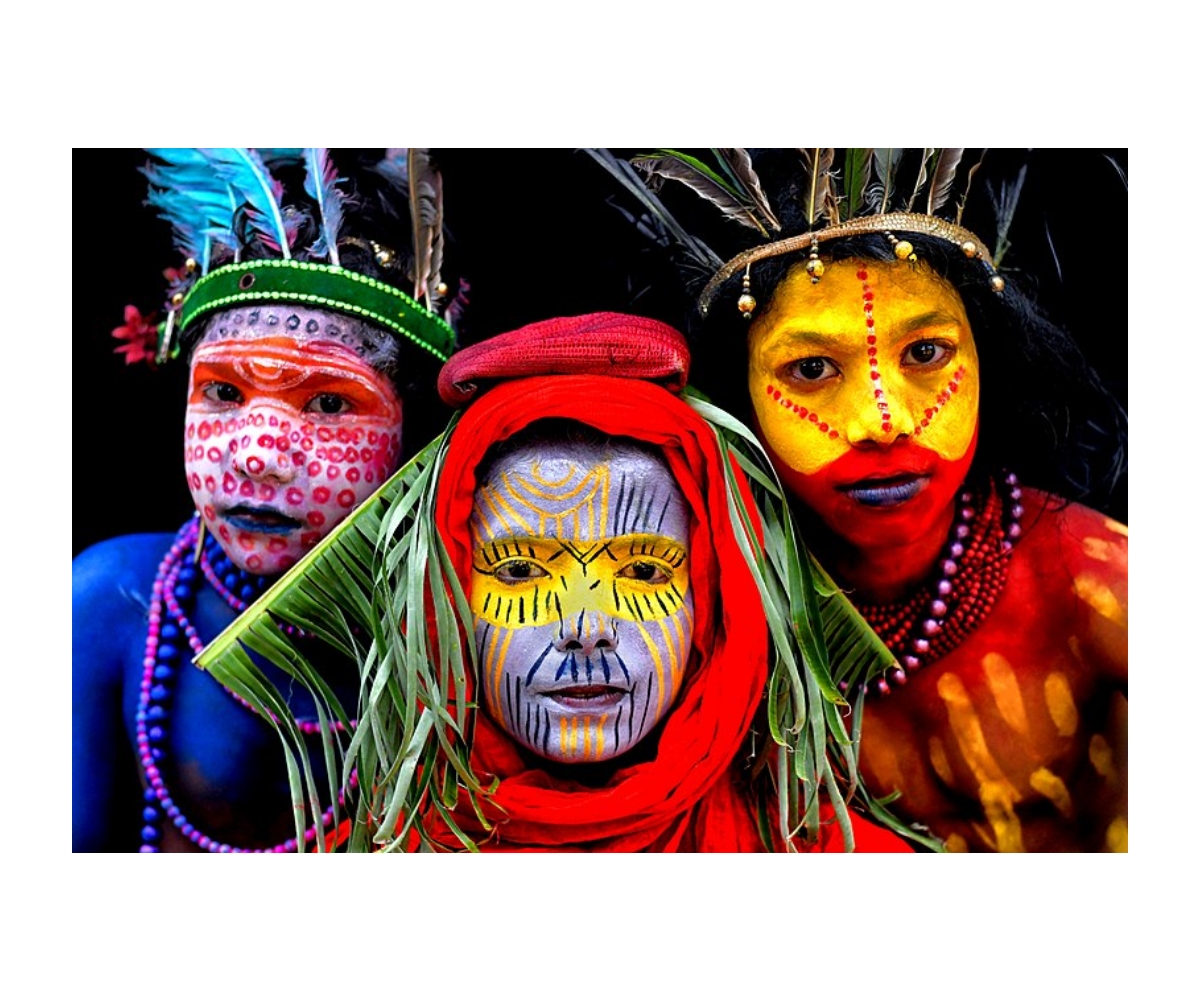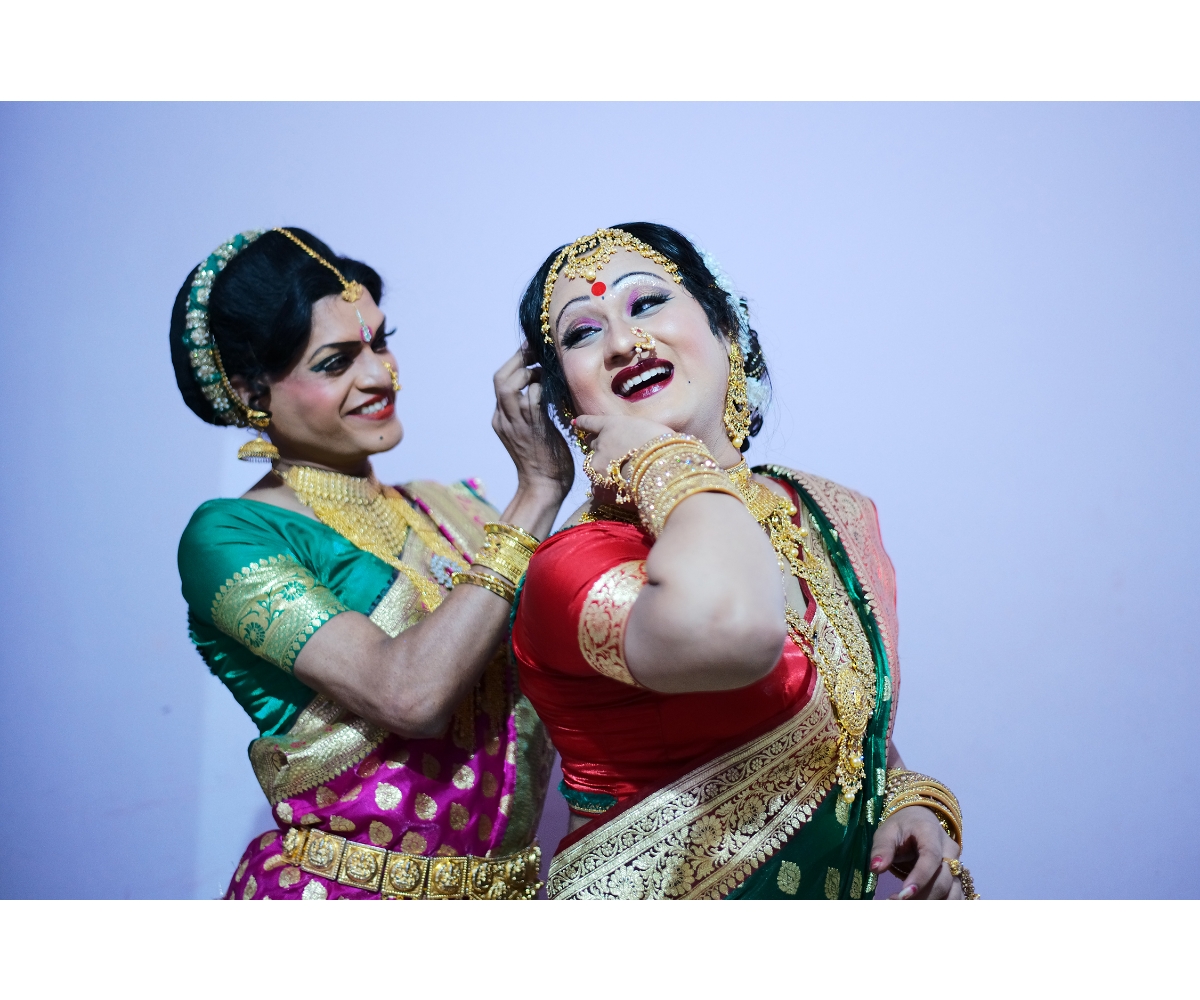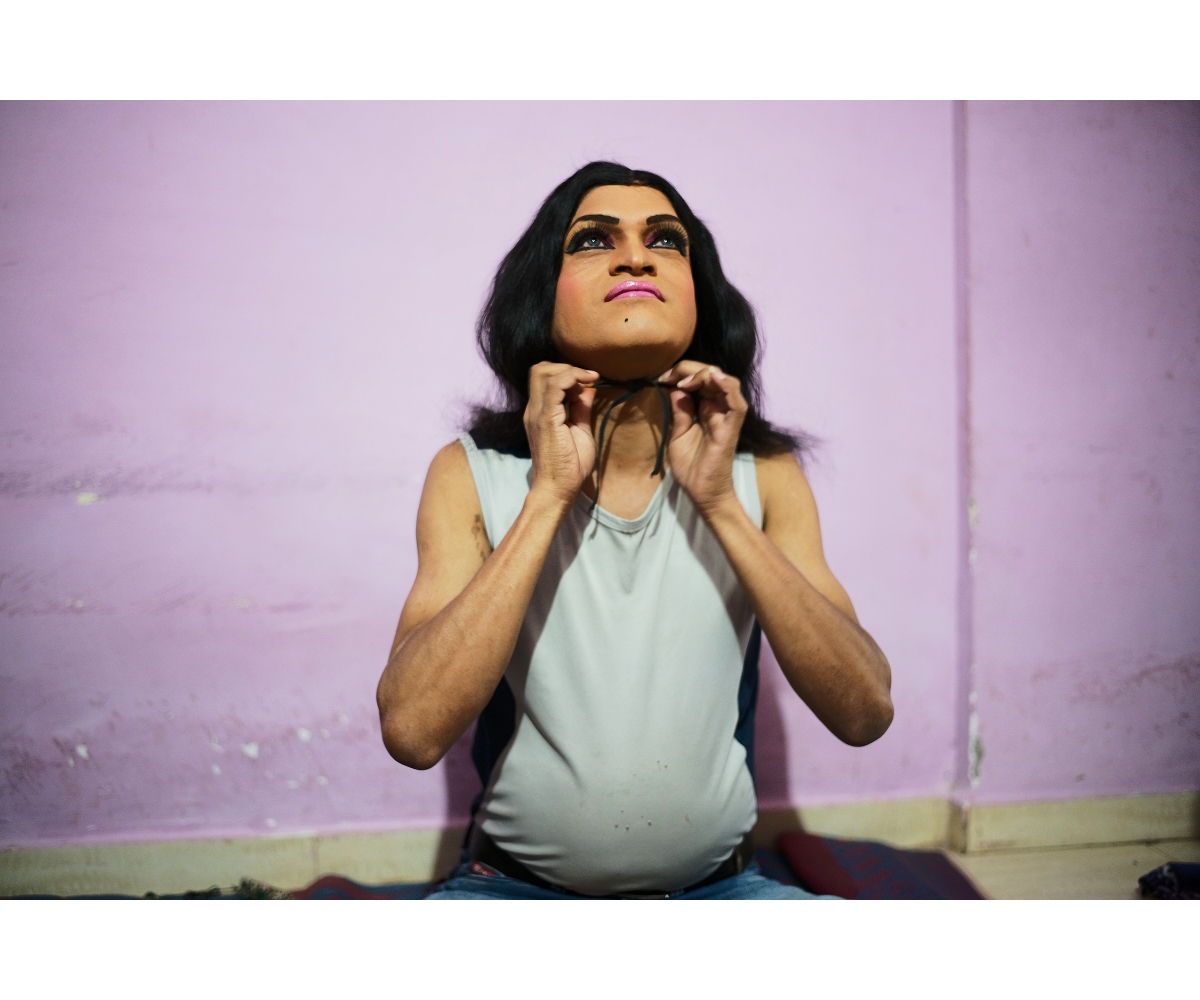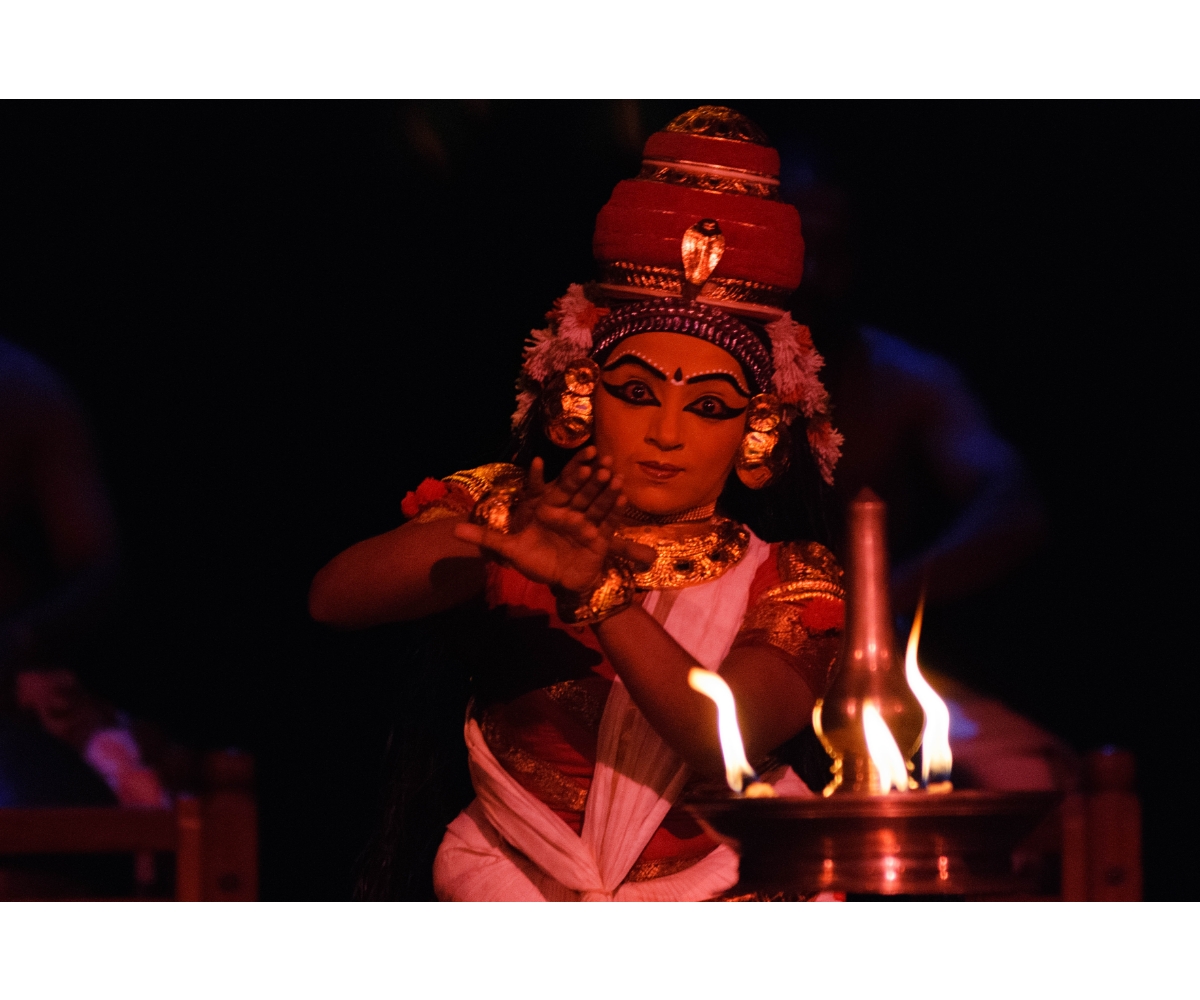STORIES
Dancing Bodies, Moving Touch: Textiles, Materiality and Touch in Indian Dance
Still air comes to life — a gentle breeze stirs as cloth flares out in a fluid, spinning disk of textile and the dancer twirls, performing the chakkar or spin that is quintessential to Kathak. As we look at this image, we are transported to the incredible spectacle that is a dance performance, and reminded of the flash of jewels as the stage-lights grace the dancers’ form, the jangle of brass bells — and perhaps, just perhaps, we can even hear the music.
In another image, we see two figures hold up mirrors to their faces, gazing at themselves, completely absorbed in wielding their makeup brushes. They concentrate on the act, carefully adding touches of colour to their faces. Once this process of applying paint, wearing a costume, and looking one last time at the mirror to make finishing fixes is done, they will be ready to perform.
Although these images may at first glance seem to depict two very different traditions, movements and actions, something nearly invisible unites them — the sense of touch. From the gentle strokes of makeup brushing over skin to the weight of the bells wrapped around the ankles, the cold touch of metal jewellery, and, most prominently, the textures of the dancers’ often-elaborate costumes, an ornamentation — through touch — is crucial to most South Asian art forms. In a way, these performance-based artforms embody a confluence of the touch, ornament, textile, movement and materiality.
The symbiotic relationship between touch, bodies and objects, and the role of tactility in forging a connection between them, finds expression in American photographer Briana Blasko’s book Dance of the Weave, where she explores the link between traditional Indian dance and textiles — which have much in common — through a series of still images. As costume designer Sandhya Raman notes in the beginning of the book, they are both ‘visual, tactile and structured’ and ‘driven by passion and complement each other’.
Through Blasko’s images, we are able to observe and marvel at the entire body engaged in a sensory exercise, as the dancer’s body is in touch with cloth, manipulating it to ‘dance’ too.
When the dancer moves, the movement lingers, carried forward in the costume’s pleats and pallus, seemingly embarking on a touch-based choreography of its own. In Blasko’s image of the Kathak dancer mid-spin — with the skirt extended in a circle around the dancer, subtly following her movement and making its own spins — we feel the weight of the dancer’s body transmitted onto, and giving new life to, the light fabric she wears. The performance itself is transferred from body to textile, through the skin, and through touch. The image draws our attention to the materiality of the textile and its interaction with the skin of the dancer, and to how, through touch, there is movement in the continuum. The material flows and moves, guided by the skin, creating a ‘fabric origami’. In her images of Bharatanatyam and Odissi dancers in unstitched drapes or dance practice saris, we see how the colour, texture and design of the fabric as well as the way the drapes flow or make creases on the saris accentuate, shape or mask the contours of the dancer’s body, elevating and complementing the postures that are so vital to the form.
In performance traditions from across the subcontinent, one notices how costume, especially clothing, ‘inhabits’ the body, engaging in a tactile conversation with it. As the scholar Priya Srinivasan writes in her Sweating Saris: Indian Dance as Transnational Labor — ‘the sari constructs the dancing body’.
Ornaments and makeup are often part of the visual spectacle of a performance, and in observing performers getting ready, we are able to see a different kind of tactility. For example, in an image of a Kathakali performer in his greenroom, the skin of his face is painted with traditional ‘paccha’ or ‘green’ makeup. The colours are applied patiently onto the face — the skin is still, and the cool, wet natural paint slowly coats it with a sweeping brush in a process that takes hours of work. Each colour determines the character the actor plays. Paccha, for example, represents a pious and noble character, such as the Hindu god Rama from the epic Ramayana, while red represents evil. As his skin ‘touches’ the paint, the actor begins the process of metamorphosing into the character — without this touch, he is not yet a transformed performer, not yet a god.
Aharya, Abhinaya and Sparsha: Bridging costume and performance through touch
Touch occupies a significant place in Indian schools of thought, where sensory awareness of the body is given much importance. The 11th century Kashmiri philosopher Abhinavagupta, who is well known for his works on aesthetics, dance and drama, believed touch, or sparsha in Sanskrit, to be the highest of the senses. In Tantraloka, an exhaustive text on Tantric philosophy, he describes touch as going beyond the physical and bringing one closer to the divine. To touch is to ‘know the Self by knowing the Other’, the highest form of awareness. Therefore, he believed — unlike in orthodox Brahminical thought where touch, associated closely with notions of ritual purity, becomes exclusive and oppressive — that touch had the capacity to liberate.
Meanwhile, Buddhist schools refer to the six senses (the sixth being the activity of the mind) as being activated through sparsha, or phassa (in Pali) — meaning touch or contact. The coming together of the sensory organ and corresponding object through contact — such as body-contact, ear-contact and nose-contact — is believed to give rise to specific kinds of consciousness. Here, a distinction is made between sparsha as physical touch — one of the ayatanas or ‘sense-doors’ (called thus as the senses are considered as portals to experiencing the world) — and sparsha as sensory contact in general. In Indian performance arts, we see an interplay of both these ideas, as bodies and objects come in close contact, moving and expressing with and through one another.
In many traditional dance forms of the Indian subcontinent ‘aharya’, or costume, makeup and ornamentation, is considered a mode of expression, or ‘abhinaya’, in itself, alongside gestures, spoken words, and facial expression. The eight-metre long turban wrapped around the head of the Sattriya dancers of Assam; the sparkling ghagra skirts and sheer veils worn by Rajasthani women as they perform Ghoomar; the white and gold cloth that drapes Kerala’s Mohiniattam dancers; the masks worn by Chhau performers in Bengal and Jharkhand; and the red alta dye painted over the hands and feet of most South Asian dancers, all form part of aharya and are as important to a performance as the form itself. This adornment of the body happens through, and is facilitated by, sparsha. It is through touching and being touched by the costume, makeup and stage props that the dancer becomes ready to perform. The skin, both the organ and object of touch, transmits sensations and allows a person to embody a performance, which then becomes integral to the performance. There is no performance without costume, and there is no meeting of the performer and costume without the conduit of touch.
Becoming: Transformation and embodiment through touch
Makeup is fundamental to most South Asian performance traditions. The application of face and body paint are sometimes also highly ritualised and follow traditional guidelines, as is seen in Theyyam and Therukoothu, and the makeup itself is believed to ritually charge the performance space. As in Kathakali, the hues of dyes used in Therukoothu along with the specific motifs applied on the skin of the performer help define the qualities of the character that they portray. In the Piliviesha or ‘tiger dance’ of Karnataka, young men paint their body in shades of orange and white with black stripes, performing in the guise of tigers. In observing the painted skin we are able to understand sparsha, in this case of paint, as going beyond just adornment, to help the dancer or actor embody a character, while also setting the mood for a performance. The tactile contact of makeup on the skin not only possesses a transformational power, but also opens new sensory doors to experiencing the world, albeit through the body of the character one plays rather than one’s own.
Touch becomes the vital first step not only in becoming a character but also in the process of impersonation as well as the performance of gender. Instances of cross-dressing and female impersonation — as seen in male Kuchipudi artists donning the stri vesham or playing female characters wearing traditional makeup and female costumes, or Launda Naach where older men dress up and perform as women — at once blur and solidify the constructions of gender. They present a rather subversive visual of male bodies performing femininity, while also reiterating patriarchal visions of how a woman should dress, walk, dance, behave. In Bengal and other parts of India, the Bahurupis, literally meaning ‘those with many forms’, are known for impersonating multiple characters through acting and improvisation, with the touch of face paint and costumes yet again playing a significant role in enabling these transformations.
In a way then, tactility, starting from the intimacy of the skin, also allows us to go beyond the physical body, opening up possibilities to transform. Writing about the ‘haptic sense’ — meaning, ‘of or relating to the sense of touch’ — in Kutiyattam, a centuries-old form of Sanskrit theatre from Kerala, performance scholar Mundoli Narayanan speaks of how Kutiyattam actors, simply through elaborate eye movements and hand gestures, make the audience feel the texture of the objects they are enacting. Touch, here, whether physical or not, has an affective quality — an ability to simultaneously make us feel the touch as well as feel ‘touched by’ it.
Touching through the body
We think of touch as channelled primarily through our hands, when in reality we touch through our entire bodies as well as our other senses, as described in the concept of sparsha. Even as we move through life, performing little everyday actions, whether it is applying wet eyeliner with a narrow brush onto delicate eyelids, letting cool pearls settle around our necks, pulling on a silken shirt, or even grabbing a hand-rail as we walk down stairs, we are constantly negotiating with our surroundings through touch.
With Dance of the Weave, we are also brought to understand how dance, or performance in general, brings the focus back onto touch by putting tactile bodies on display, as they move, touch, connect and move apart, in contact with the fabrics, paints and ornaments they wear, and with the dance floor through the touch of their feet. While performance itself is a piecing together of myriad elements — costume, stage, jewellery, makeup, props and curtains, alongside the work of performers and their labouring bodies — each of these is brought alive by touch. Even our memories of these performances are quintessentially tied to our tactile memory of the flowing skirts, painted bodies and ornamental headgear.
Through such a reading of Blasko’s work, a new way of thinking is opened to us. If we take a moment to step into ourselves and think about, or rather, feel, the various textures, temperatures and materials we are in contact with at any given moment, we are meditating on the one sense that never really leaves us. To acknowledge and be aware of touch, is to understand the myriad ways in which we respond to and situate ourselves in the world around us.
Bibliography
Anand, Abhinav. “The ‘Launda’ in Launda Naach: Tracing the Politics of Female Impersonation.” Sahapedia. October 2021. https://map.sahapedia.org/article/The-%E2%80%98Launda%E2%80%99%20in%20Launda%20Naach:%20Tracing%20the%20Politics%20of%20Female%20Impersonation%20%20/11412
Blasko, Briana. Dance of the Weave: A Dialogue between Traditional Textiles and Dance in India. Penguin Enterprise, 2013.
Classen, Constance. The Deepest Sense: A Cultural History of Touch. Champaign, IL, 2012; online edn, Illinois Scholarship Online, 20 April 2017. https://doi.org/10.5406/illinois/9780252034930.001.0001.
Fraleigh, Sondra Horton. Moving Consciously: Somatic Transformations through Dance, Yoga, and Touch. Urbana, IL: University of Illinois Press, 2015.
Kamath, Harshita Mruthinti. Impersonations: The Artifice of Brahmin Masculinity in South Indian Dance. Oakland: University of California Press, 2019.
MAP Academy Encyclopedia of Art. “Bahurupi.”, Article. April 21, 2022. https://mapacademy.io/article/bahurupi/.
MAP Academy Encyclopedia of Art. “Theyyam.” Article. April 21, 2022. https://mapacademy.io/article/theyyam/.
MAP Academy Encyclopedia of Art. “Therukoothu Masks.” Article. April 21, 2022. https://mapacademy.io/article/therukoothu-masks/.
Mitra, Royona. “Unmaking Contact: Choreographic Touch at the Intersections of Race, Caste, and Gender.” Dance Research Journal 53, no. 3 (2021): 6–24. https://doi.org/10.1017/s0149767721000358.
Narayanan, Mundoli Vasudevan. Space, Time and Ways of Seeing: The Performance Culture of Kutiyattam. United Kingdom: Routledge, 2022.
Rabarison, Karolle. “The Weavers’ Dance,” The Morning News, January 4, 2013. https://themorningnews.org/gallery/the-weavers-dance.
Skora, Kerry Martin. “The Hermeneutics of Touch: Uncovering Abhinavagupta’s Tactile Terrain.” Method & Theory in the Study of Religion 21, no. 1 (2009): 87–106. http://www.jstor.org/stable/23555698.
Srinivasan, Priya. Sweating Saris: Indian Dance as Transnational Labor. Philadelphia: Temple University Press, 2011.




